The lack of sales and marketing alignment is so common that it can seem:
- Like one of those things that’s never going away and therefore not worth talking about. Hint: it is worth it.
- Too overwhelming to solve. Hint: it doesn’t have to be.
Here are seven straightforward projects that can help get these two important teams on the same page, broken down by the three areas where alignment tends to fall apart: customers, content, and social media.
Align sales and marketing around the customer journey
If there’s one thing sales and marketing team members always agree on, it’s that none of us would be here without our customers.
That’s why customer-focused projects are the perfect place to start aligning your sales and marketing efforts. If you both start from a place of mutual understanding about how best to serve your customers, it’s easy to build out and keep up with workflows that align sales and marketing around your customers’ journey.
Alignment project #1: Collaborate on creating your ideal customer profile and buyer personas
Ideal customer profiles (ICPs) and buyer personas help you define your target audience using both quantitative and qualitative data, so you can make smarter marketing, sales, and product decisions.
ICP and buyer personas contain different information:
Buyer personas are detailed profiles of individual decision-makers, based on real data and research. They help sales and marketing teams craft messaging that resonates with specific types of buyers, like a Marketing Director or Sales Manager.
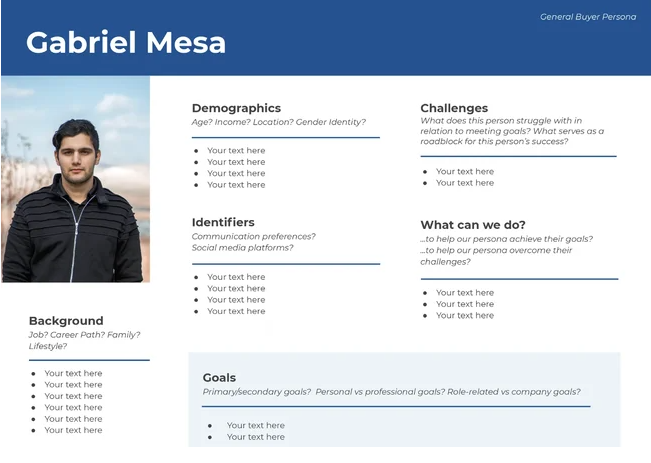
Image source: HubSpot
Ideal customer profiles (ICPs) describe the broader characteristics of a company that’s a perfect fit for your product, such as industry, company size, or revenue.

Image source: Hubspot
How can sales and marketing teams collaborate on buyer personas?
Start by identifying your core buyer personas based on your actual customer base. These should reflect the key decision-makers you sell to — for example, a Marketing Director, Sales Manager, or CEO.
Next, build out each persona using a mix of qualitative and quantitative research:
- Review CRM and sales data
- Conduct customer interviews
- Analyze patterns in goals, challenges, and buying behaviors
This gives your sales and marketing teams a shared view of who they’re speaking to — and how to engage them effectively.
Want to go deeper? Check out this step-by-step guide to creating buyer personas and download free persona templates to get started.
Alignment project #2: Establish a process for gaining, sharing, and leveraging the latest customer insights
Marketing teams want more customer insights, but they’re often too far from the customer to get them.
Sales has those insights, but they’re usually too focused on closing the next deal to pass them along.
Most companies don’t have a reliable process for closing that gap. As a result, customer feedback rarely makes it into content, messaging, or strategy.
Here’s how to fix that.
How to share customer insights across sales and marketing
Start by getting buy-in
Let marketing lead the process, but involve sales early so they can help shape how it works.
Run a quick kickoff call or send out a short survey. Make sure everyone knows:
- What you’re trying to do
- Why it matters
- How little time it’s going to take
If you want reps to log insights, you’ll need to sell them on the value.
Set up easy ways to share feedback
Implement regular communication channels to share customer insights. Use tools your teams already check:
- CRM
- Slack
- Intranet or enablement platform
You might also need regular joint meetings to gather feedback from frontline sales representatives, analyze data from various touchpoints, and integrate insights into marketing strategies and sales approaches.
During the meetings, teams can analyze the gathered insights to identify patterns, preferences, pain points, and emerging trends among customers.
Add tools to do the heavy lifting
Conversation intelligence software helps pull insights from sales calls without anyone having to watch full recordings. Meetings AI is another useful tool.
They can usually tell you:
- Which keywords came up the most
- Who spoke (and for how long)
- What topics triggered objections or questions
All of this can help marketing refine messaging.
Give reps specific questions to ask
Don’t just ask reps to “share insights.” Give them a short list of questions to work into conversations, like:
- “How did you find us?”
- “What problem were you hoping to solve?”
Add these prompts to call prep docs or follow-up workflows so they don’t get forgotten.
Make win/loss reporting part of the process
Ask reps to log:
- Why the deal closed or didn’t
- What questions came up
- What the buyer cared about most
- Which competitors were in the mix
Make it part of your sales process, not an optional step.
Put the insights to work
Once you’ve got real customer feedback coming in, don’t let it sit in a doc no one opens.
Use it to:
- Adjust messaging and content
- Shape outbound strategy
- Train reps
- Improve your positioning
And keep the loop going. Revisit what you’re collecting and how it’s being used.
Alignment project #3: Define, refine, and coach messaging to use with customers
Nothing is more confusing to a prospect than receiving six different answers to the question “So, what does your product do?” from six different people. Consistency in messaging— and making sure sellers are truly buyer-ready — is key.
How to create consistent messaging across sales and marketing
Create simple training and coaching materials
Marketing and sales enablement should work together to create:
- Short training presentations
- Messaging one-pagers
- Pitch practice assignments
These should include the latest updates to product, positioning, and language, and give reps a chance to learn and practice before they’re in front of a customer.
Coach the message, not just the deck
If you’re not using a coaching platform, start by training reps in meetings. Then ask sales managers to follow up 1:1. This depends on the availability of sales managers to provide this coaching so it may take some time to make sure every seller has nailed the messaging.
Use a coaching platform to scale faster
A sales coaching platform helps make sure everyone is using the same language and telling the same story when writing or speaking to customers:
- Sellers can practice messaging, test how it does with customers, and deliver any relevant feedback to marketing to refine messages over time.
- Marketers can work with sales enablement and sales managers to create training presentations and messaging pitch assignments for reps to give sales a direct line to the latest product and brand updates from marketing so everyone is speaking the same language.
Sales enablement tools with video and/or AI coaching capabilities allow managers to assign tasks to their team and rate and review their submissions through time-stamped comments and stars.
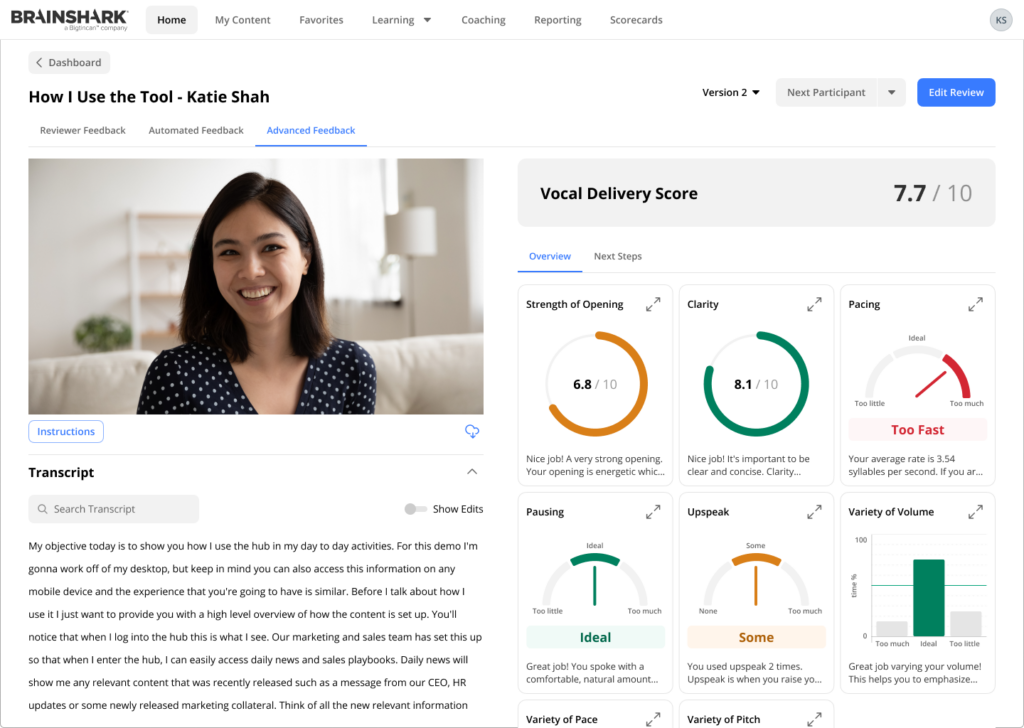
Pictured: Video coaching tool with AI feedback in Bigtincan Readiness (Brainshark)
This makes it easy (and less awkward) for the sales team to submit a pitch. They simply record directly from their device and upload it into the tool. Managers can be notified when submissions are entered, and the salesperson is notified when their submission has been reviewed.
Want an easier way to coach reps at scale?
Bigtincan’s RolePlayAI lets your team practice real-world selling scenarios in a risk-free environment and get instant, actionable feedback.
No scheduling required. Just better coaching, faster.
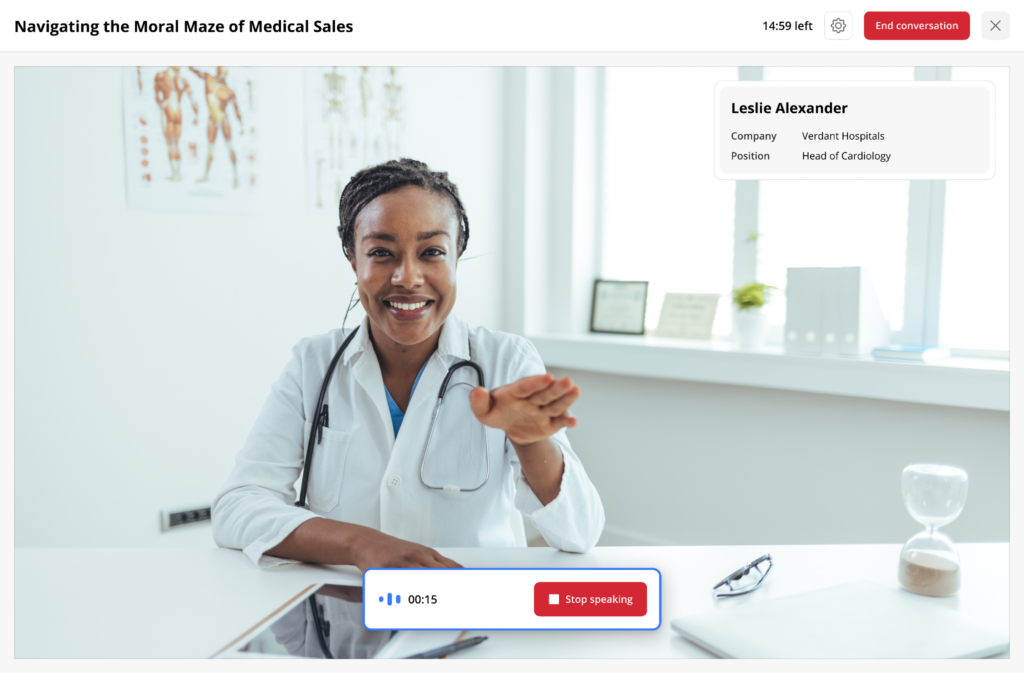
Build a shared sales and marketing content strategy
A shared content strategy isn’t just about what marketing creates. It also needs to include input from the people who talk to customers every day.
Alignment project #4: Set up a process and/or venue where sellers can submit content recommendations and requests to marketing
Sellers need content. Marketers create it. And when the process between them is messy, slow, or nonexistent, both sides end up frustrated.
Since introducing the right content to the right customer at the right time is paramount to modern buying journeys, setting up a process and/or venue where sellers can submit content recommendations and requests to marketing is an essential step that will help improve your sales and marketing alignment.
Plus, documenting content recommendations and requests in a more concrete way is a fantastic way to ensure that sales and marketing both know what’s being prioritized, and that the resulting content benefits both teams and customers the most.
How to collect content feedback from the sales team
Set up a lightweight request form
Start by creating a short, structured form in a shared tool your teams already use: Wrike, Jira, Notion, your intranet, wherever.
The form should include:
- A space to describe the content need or idea
- A required field explaining why it’s needed (e.g. “keeps coming up in demos”)
- Any key context: audience, use case, deal stage, etc.
Tip for marketers: Create a form that isn’t too long or complicated but still includes all of the criteria you need to limit follow-ups with the requester for clarification.
Once you create your form, you need to repeatedly distribute it to the appropriate people and gently enforce adoption of the form. When people try to bypass the form in Slack, email, or other channels, things get lost in translation and you’re back to square one.
Here’s an example of a content request form for sales teams:
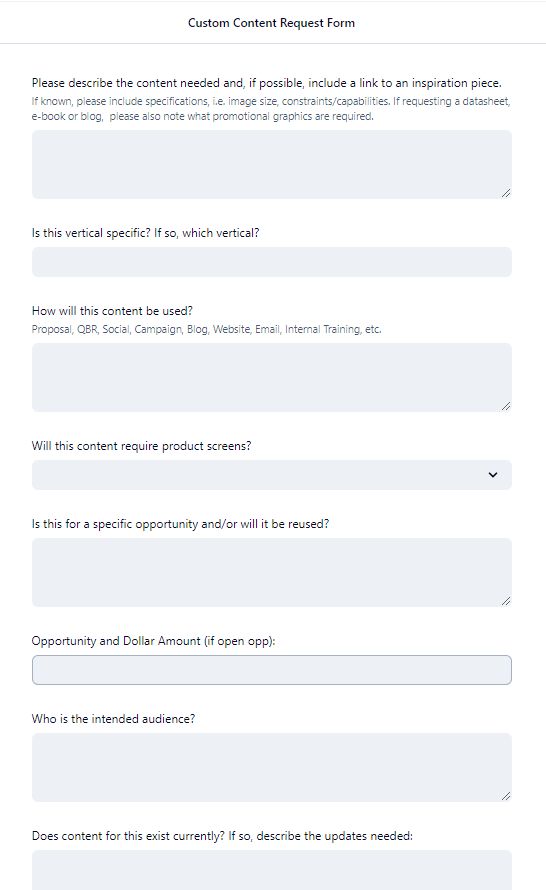
Want to make sure the content you create actually supports sellers?
Check out these sales enablement content best practices to guide your strategy.
Alignment project #5: Audit and map your content in a matrix to assess need
In many cases, the marketing team is constantly churning out content, but the sales team doesn’t know what is there, why it was created, or which content to send to which customers.
A simple fix: conduct an audit and organize all your existing content into a content matrix.
How to audit and map your content so Sales can find it
Build a basic content matrix
Start with something simple — a spreadsheet or table that maps content by:
- Buyer persona
- Stage of the funnel (awareness, consideration, decision)
Here’s an example:
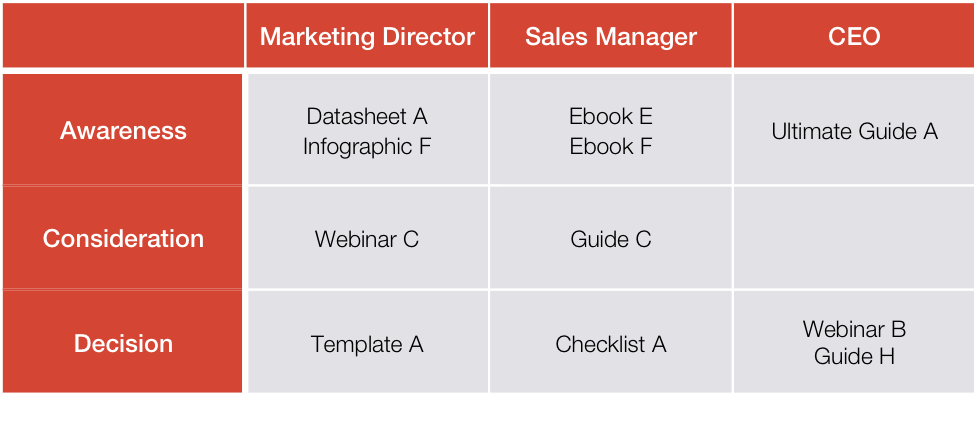
Loop in sales early so you can collect content that’s floating around in inboxes, shared drives, or decks.
Once you’ve filled it out, review the matrix to spot gaps. Which stages or personas are underserved? Where are reps stuck without a resource that moves the deal forward?
The matrix should then be consistently updated on a quarterly basis (or as often as possible) and made available for the sales team to view.
Pro tip: If you’re a large enterprise, growing rapidly, or you’re all prolific content creators, it’s time to consider a content management system other than Google Drive or SharePoint.
Getting lost in content chaos?
Learn how to build a shared GTM system that keeps everyone aligned, from sales decks to persona content.
Alignment project #6: Create editable templates for your sales team
Having a template for the common types of content your team uses (with editing controls) encourages content usage by sales teams, while also ensuring branding and regulatory/legal control.
Decks, datasheets, and other content delivered to prospects and customers is personalized, editing is quick and easy for busy sellers, and marketing still holds the reins. Everybody wins!
How to create editable content templates for sales
Using Google Slides and Docs templates or a document automation tool are the simplest ways to create editable templates. Just be aware that Google templates will limit what types of content templates you can create as well as how sophisticated they are in terms of branding and other visual elements.
For enterprise sales and marketing teams, a document automation tool is preferable and scalable. A document automation tool lets marketers build templates, import assets, and define content areas as either fully editable, swappable, or restricted for an even finer degree of control over branded content.
Struggling to get sales and marketing on the same page?
If your teams are working from different systems, using different content, and speaking different languages, no amount of meetings will fix it.
This webinar shows how to simplify your GTM setup so everyone’s pulling in the same direction — and spending less time digging for the right slide.
Align sales and marketing on social media strategy
One of the fastest ways to grow your social reach, without relying on ads or brand channels, is to get your employees sharing the right content at the right time.
Alignment project #7: Implement an employee social advocacy initiative
When sales and marketing work together on social media, it’s a win-win:
- Sales teams can expand their networks and engage buyers through social selling.
- Marketing gets wider content distribution that doesn’t rely solely on the brand account (which fewer people are interested in).
How to get sales and marketing teams to share content on socials
There are more and less manual ways to achieve this depending on your budget and other resources.
Start with a simple, manual process
If you don’t have budget for a platform, you can still get results by making it easy for people to share.
Ask your social, content, or community team to:
- Write short, copy-and-paste-ready posts
- Include links to articles, awards, webinars, or announcements
- Share regularly via Slack, email, or your intranet
Keep the cadence realistic, and focus on content that feels useful or interesting to share, not overly promotional.
Upgrade with an employee advocacy platform
The recommended and preferable option is to implement an employee social advocacy platform that automates, speeds up, and improves the process described above. With an advocacy platform, you will also get performance data on employee posts showing you how many people you’re collectively reaching and which posts get the most engagement.
Want a faster path to sales and marketing alignment?
These projects are a great starting point, but if you’re ready to simplify your GTM strategy and get everyone pulling in the same direction, don’t miss our webinar:
